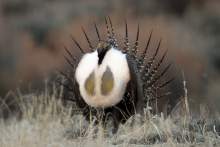This is an archived article that was published on sltrib.com in 2015, and information in the article may be outdated. It is provided only for personal research purposes and may not be reprinted.
The U.S. Fish and Wildlife Service does not plan to enact endangered-species protection for a small population of sage grouse on the California-Nevada border.
And wildlife directors across the West — including Utah — hope that is an indication of things to come.
Federal wildlife managers announced Tuesday that the Mono Basin sage grouse, also commonly called the bi-state population, will not be listed as an endangered or threatened species after conservation and restoration efforts on public and private lands on its range.
"The threats are no longer of a magnitude that would require listing," Mary Grim, regional sage grouse coordinator for the U.S. Fish and Wildlife Service, told The Associated Press.
State wildlife managers in 11 Western states hope to hear the same thing when Fish and Wildlife announces whether or not the greater sage grouse should be listed later this year.
"This is exciting news," Utah Division of Wildlife Resources Director Greg Sheehan said. "It's an indication the Fish and Wildlife Service is willing to take a serious look at the conservation efforts happening out there and [is] acknowledging that we are making progress."
But Sheehan says more still can be done to protect the birds without a federal listing.
State officials often feel entangled in the red tape of Endangered Species listings and the requirements attached when a species is listed as threatened or endangered.
"I've maintained all along," Sheehan said, "that listing is not the best thing for these birds."
Greater sage grouse habitat stretches across Washington, Oregon, Idaho, Utah, Wyoming, Montana, Colorado, North Dakota and South Dakota. Current estimates of the bird's regional population numbers range from 200,000 to 400,000.
A Fish and Wildlife Service announcement for greater sage grouse is due Sept. 30.
Federal wildlife managers identified the bi-state population as a distinct subspecies in 2010.
Grim said they worried about the rate of habitat loss when they first proposed listing the bird as threatened two years ago.
Since then, groups including ranchers, gold mine owners and local government leaders have committed more than $45 million to restoration efforts during the next 15 years, making the listing unnecessary, she said.
"If you look at the science, look at the commitments we have, clearly in comparison to 2010, the future looks very bright for bi-state sage grouse," Grim said. "There's no reason to think the subspecies is at risk now or in the future of going extinct."
The community rallying to keep the greater sage grouse off the list is taking Tuesday's announcement as a good sign that efforts to restore and protect the birds are headed in the right direction.
"Today's decision is great news for this population of sage grouse and all the stakeholders who rolled up their sleeves and demonstrated that the states can work with the federal government to achieve a positive outcome," Miles Moretti, president and CEO of the Salt Lake City-based Mule Deer Foundation, said in a release from the Theodore Roosevelt Conservation Partnership. "We're poised to get the same result for the remaining populations of sage grouse, if we stay the course and don't back away from strong conservation efforts that will benefit all sagebrush-dependent species."
Last fall, Fish and Wildlife Service Director Dan Ashe emphasized that the listing of the Gunnison sage grouse as "threatened" in southeastern Utah and southwestern Colorado was not to be taken as an indication of how the greater sage grouse decision would come down.
Colorado is suing Fish and Wildlife over the Gunnison sage grouse listing. And Sheehan said Utah has joined the suit.
"This is a demonstration that the model works, but the devil is in the details," said Theodore Stein, a Fish and Wildlife Service spokesman out of Denver. "The bi-state plan was built with a lot of local involvement and commitments. They were also able to obtain significant funding commitments to do the work. That gave us a high level of confidence that effective measures were being taken to address threats to the population."
Unlike the bi-state population, which is evenly distributed on its range, the Gunnison sage grouse is "clumpy," with small satellite populations and changing factors limiting the ability of those populations to rebuild, Stein said.
Jason Weller, chief of the U.S. Department of Agriculture's Natural Resource and Conservation Service, said the steps taken in Nevada and California should be used as a model to head off a potential listing of the greater sage grouse.
"Today's decision is only for the bi-state sage grouse, but it gives me great hope and optimism," Weller said. "I hope folks take a hard look at this decision, the key ingredients and what we can learn from that and apply those to the greater sage grouse, because that's what's up next."
U.S. Department of Interior Secretary Sally Jewell agreed with Weller on Tuesday.
The "collaborative, science-based efforts" on the bi-state population are "proof that we can conserve sagebrush habitat across the West while we encourage sustainable economic development," she said.
Twitter: @BrettPrettyman
The Associated Press contributed to this story



